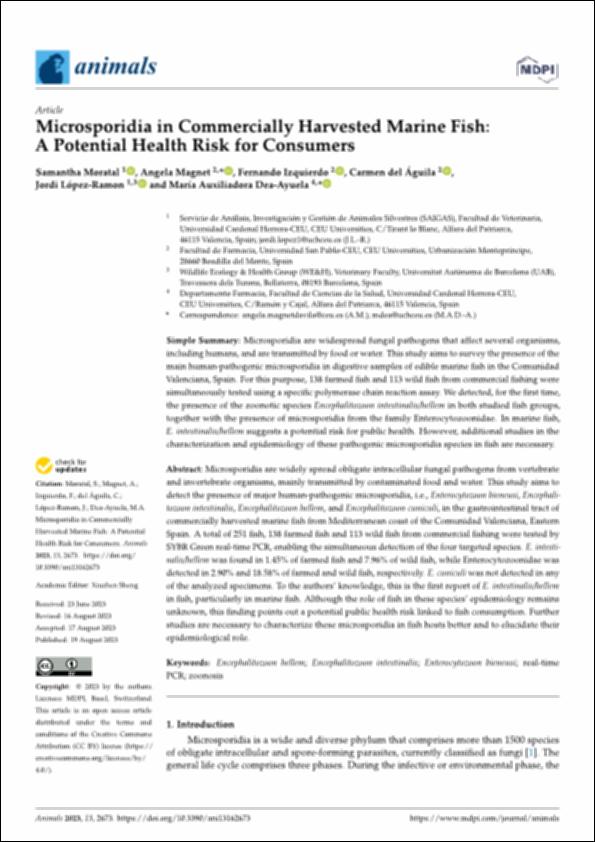Por favor, use este identificador para citar o enlazar este ítem:
http://hdl.handle.net/10637/14920Microsporidia in commercially harvested marine fish: a potential health risk for consumers
| Título : | Microsporidia in commercially harvested marine fish: a potential health risk for consumers |
| Autor : | Moratal, Samantha Magnet, Angela Izquierdo Arias, Fernando Águila de la Puente, Carmen del López Ramon, Jordi Dea Ayuela, María Auxiliadora |
| Materias: | Enfermedad transmisible; Infectious diseases; Veterinaria; Veterinary medicine; Epidemiología; Epidemiology; Consumo alimenticio; Food consumption; Parasitología; Parasitology; Pez marino; Marine fish |
| Editorial : | MDPI |
| Citación : | Moratal, S., Magnet, A., Izquierdo, F., Del Águila, C., López-Ramon, J. & Dea-Ayuela, M.A. (2023). Microsporidia in commercially harvested marine fish: a potential health risk for consumers. Animals, vol. 13, i. 16 (19 aug.), art. 2673. DOI: https://doi.org/10.3390/ani13162673 |
| Resumen : | Microsporidia are widely spread obligate intracellular fungal pathogens from vertebrate and invertebrate organisms, mainly transmitted by contaminated food and water. This study aims to detect the presence of major human-pathogenic microsporidia, i.e., Enterocytozoon bieneusi, Encephalitozoon intestinalis, Encephalitozoon hellem, and Encephalitozoon cuniculi, in the gastrointestinal tract of commercially harvested marine fish from Mediterranean coast of the Comunidad Valenciana, Eastern Spain. A total of 251 fish, 138 farmed fish and 113 wild fish from commercial fishing were tested by SYBR Green real-time PCR, enabling the simultaneous detection of the four targeted species. E. intestinalis/hellem was found in 1.45% of farmed fish and 7.96% of wild fish, while Enterocytozoonidae was detected in 2.90% and 18.58% of farmed and wild fish, respectively. E. cuniculi was not detected in any of the analyzed specimens. To the authors’ knowledge, this is the first report of E. intestinalis/hellem in fish, particularly in marine fish. Although the role of fish in these species’ epidemiology remains unknown, this finding points out a potential public health risk linked to fish consumption. Further studies are necessary to characterize these microsporidia in fish hosts better and to elucidate their epidemiological role. |
| Descripción : | Este artículo pertenece al número especial "The Epidemiology, Diagnosis and Prevention of Infectious Diseases in Wildlife". |
| URI : | http://hdl.handle.net/10637/14920 |
| Derechos: | Open Access http://creativecommons.org/licenses/by/4.0/deed.es |
| ISSN : | 2076-2615 (Electrónico) |
| Fecha de publicación : | 19-ago-2023 |
| Centro : | Universidad Cardenal Herrera-CEU |
| Aparece en las colecciones: | Dpto. Producción y Sanidad Animal, Salud Pública Veterinaria y Ciencia y Tecnología de los Alimentos |
Los ítems de DSpace están protegidos por copyright, con todos los derechos reservados, a menos que se indique lo contrario.


